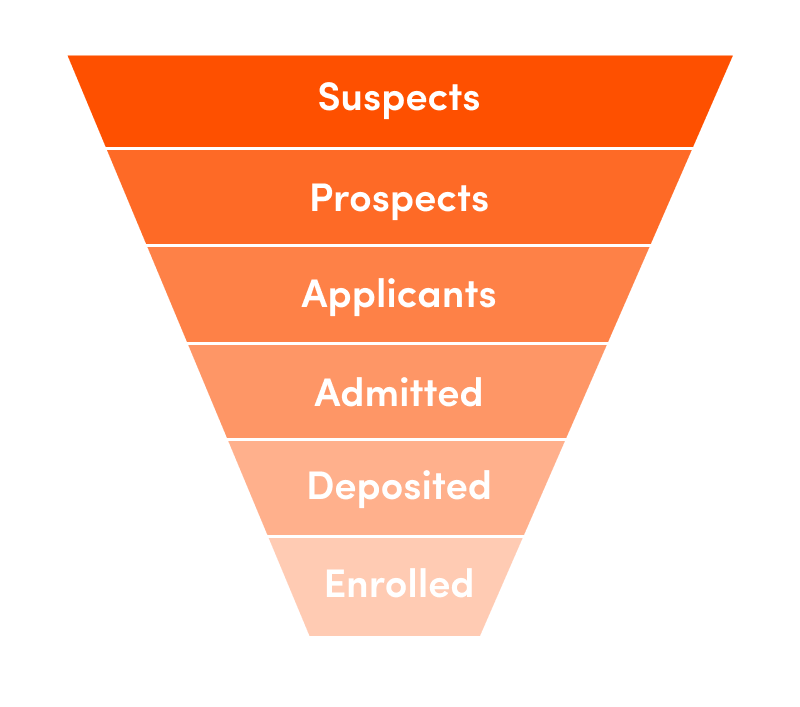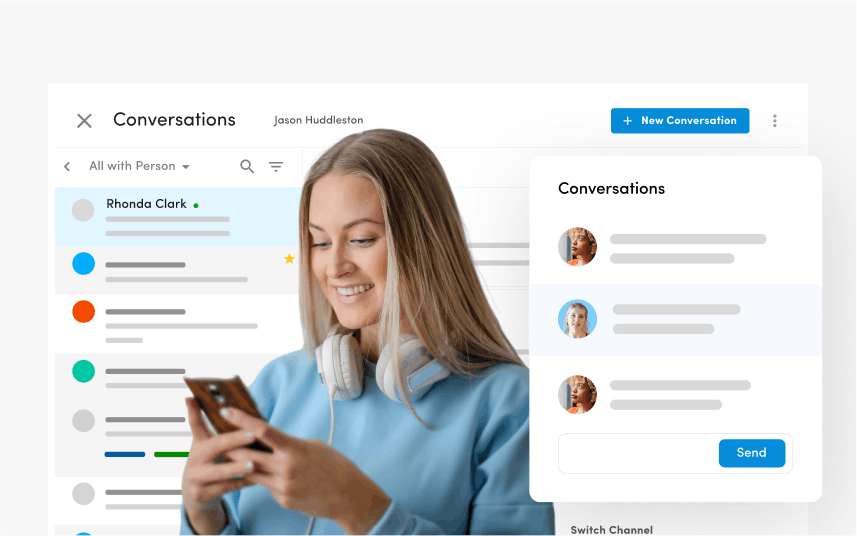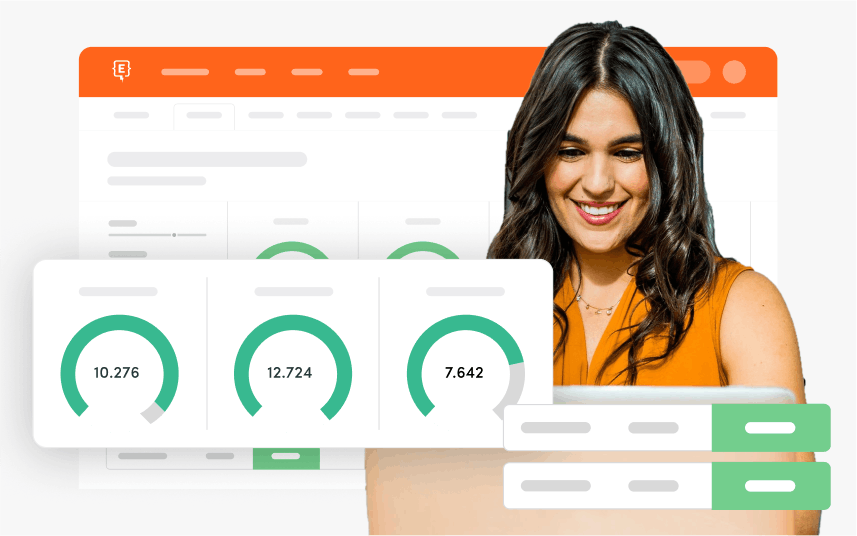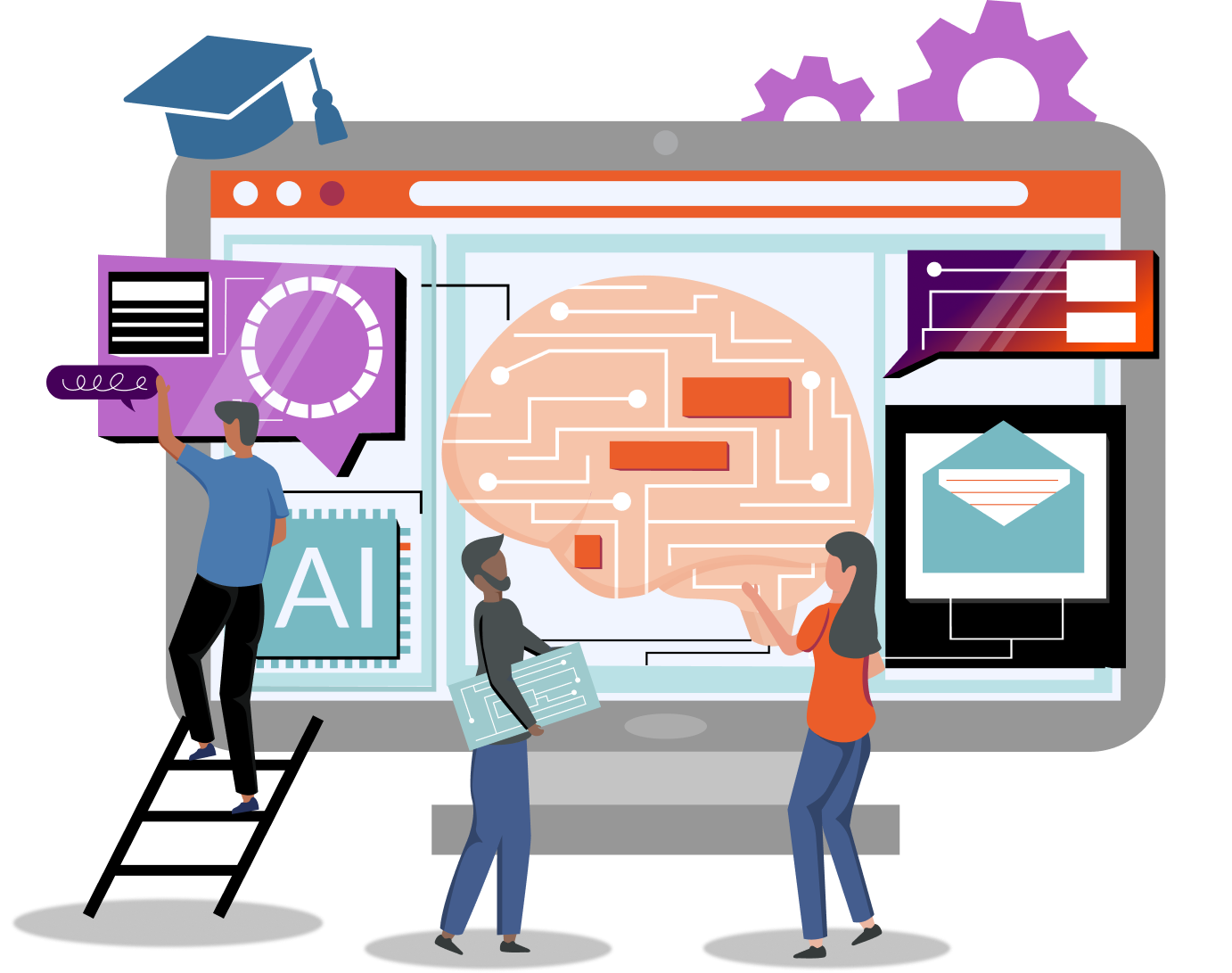The College Admissions Funnel in 2024 | Element451
by Sirley Carballo · Updated Feb 22, 2024

The College Admissions Funnel—How to Improve this Year
Attracting prospective students is at the top of most recruiters’ to-do lists. But when you’re working with up to hundreds of students at a time, it’s easy to get lost in the enrollment marketing shuffle. Developing an application process that works for your team and prospective students is critical, as the student journey begins with those first interactions.
The college enrollment funnel involves how students enter the admissions process, with an eventual goal of enrollment. With the average student applying to five to six schools per admissions cycle, there’s always an opportunity to capture new interest—without having to adapt to a confusing and chaotic routine.
Here, we'll outline standard definitions for admissions officers and enrollment specialists and provide tips for optimizing the process to make it easier for students to enroll.
What is the Admissions Funnel?
The admission funnel is a visual way to picture how prospective college students move from first inquiry to enrollment. Similar to a typical customer funnel, student interest is first captured as a lead or prospect. Once that student “converts,” they are considered an official student or attendee.
Different institutions may separate the enrollment process into more granular sections, but in general, the funnel always includes these stops along the journey.
- Awareness
- Consideration
- Decision (bottom of the funnel for admitted students)
Every part of the funnel is a chance to connect with students in personal or practical ways. And even when admissions counselors feel confident that students are ready to enroll, abrupt changes can happen at any moment. That’s why it’s so critical to personalize your enrollment funnel approach and stay connected with students all the way through.

Stages of the College Enrollment Funnel
Although the college admissions or enrollment funnel follows a similar progression to a marketing funnel, it’s important to capture the real-life, human story behind each applicant. Although the majority of high school students report positive or satisfactory admissions experiences, no one wants to feel like just a number.
Throughout each stage of the enrollment funnel, develop a specific strategy for every benchmark. Dedicate resources to every stage so that your internal team is equipped to help students at every moment. And don’t forget—show empathy and compassion. While this might be standard practice for admissions teams, the college enrollment process is a huge rite of passage in the student journey. As a result, it’s sometimes stressful and overwhelming.
In each stage below, we’ll highlight what to expect and how to make pivotal improvements for the student experience.
Awareness Stage (Top of the Funnel)
Picture this—a prospective student receives targeted messaging from colleges and universities early on in their high school career. But the urgency builds around junior year, when students prep with standardized testing, application procedures, and virtual tours.
This stage—awareness—takes place at the top of the funnel. Students research options and begin to move on things like deadlines, financial deposit, and admissions requirements. Parents and guardians are also interested in collecting information to determine the right academic and financial fit.
On the admissions side, schools may have student data in their CRM platform or database, but it’s not as detailed as it could be. Prospect data is stored, but some leads won’t move forward. Schools should focus on high-level brand information that communicates the most important values and information about academic programs.

See Element451 in Action
Students explore and pick where they’ll earn a degree in completely new ways. Become an expert in the new world of enrollment, powered by Element451.
How it Works
Consideration Stage (Middle of the Funnel)
In the middle of the funnel, students move beyond basic contact information and interest. They’re taking more proactive steps to learn all they can about an institution by making a campus visit, meeting with recruiters or counselors, or even initiating outreach.
The consideration stage includes applicants who receive offers of enrollment. Since most students receive more than one option, part of the burden during this stage is on the student and their family.
At this point, schools should continue to provide supportive encouragement and personalized communication. Address major pain points with compelling and helpful resources that alleviate hesitations or concerns. For institutions that want to achieve a high acceptance rate, now is the time to put everything on the table.
Decision Stage (Bottom of the Funnel)
The decision stage is exactly what it seems—a chance for new students to say yes to the academic opportunity to attend a specific school. Some institutions separate this stage into different phases—offered and accepted (admitted students).
Even when students meet the admissions criteria and receive an offer letter, some of those students deflect or attend another institution.
To help with conversion, remember to use a multi-channel approach to decision-making. This means using more than one touchpoint or channel to connect with students. It also means initiating conversations with students based on how they prefer to communicate, an essential aspect of actually getting in touch with them when and how you want to.
Decision State that Leads to Enrollment
What can your admissions team do to ensure that the decision stage leads to enrollment? Maintaining strong relationships with prospective students is one of the most obvious solutions, but this doesn’t happen on autopilot.
Colleges and universities that see high conversion rates often automate some of these steps as a way to reserve staff time and resources. When you’re able to deliver personalized messaging, incentives, and targeted marketing efforts with a student engagement platform, you can focus on having in-person conversations that could be the tipping point.
4 Ways to Improve Your Admissions Recruitment Funnel in Higher Education
By maintaining a proactive admissions funnel, you can avoid significant enrollment gaps and problems. For instance, by proactively identifying potential students before they want enroll, you can ensure that those students are aware of your school and its benefits. This means that the necessary resources are in place to provide a seamless enrollment process and student orientation.
But sometimes, identifying pain points happens after a particularly challenging enrollment or admissions cycle. When this happens, there are a few things you can try or implement to help optimize the funnel moving forward.
1. Widen or Increase Your Top-of-Funnel Leads
It sounds simple, but having a larger pool to work from at the top of the process can often prevent issues later on. Regardless of how you secure more top-of-funnel leads, fill your admissions pipeline with a greater number of potential students who are eligible for personalized and targeted marketing messages.
2. Diversify Your Outreach Channels
Tap into various marketing or outreach channels (both traditional and digital) to cast a wider net for potential candidates. Diversifying might include hosting campus events, attending college fairs, or leveraging social media and targeted online advertising throughout the admissions process.
Remember: the broader the platforms, the wider the reach. Expand your digital marketing efforts so that your team is able to capture more interest and more points of interaction.
3. Test New Methods as You Go
The goal here is to eliminate churn before you hit the bottom of your funnel. Implement new marketing methods with varying segmentation strategies (changing up who you reach and at what stage). Rely on performance metrics that are actionable—meaning that you can make tangible changes right away when you identify the need to pivot.
Set goals and key performance indicators at each stage of the funnel, but particularly at the bottom. How many students did you want to see move through from top to bottom? How many applicants converted to a decision? How did a new or experimental marketing campaign actually perform in terms of increasing enrollment?
The recruitment strategies you implement in your workable admissions marketing plan may need to shift based on these performance metrics.
4. Be Agile in Response to Feedback
Always ask for feedback from prospective students, enrolled students, and their families. Implementing changes based on these practical suggestions demonstrates that you value those opinions. Flexibility also shows a commitment to providing a student-centered experience, even for institutions that want to maintain a competitive edge and increase enrollment.

A Student Engagement Platform Optimizes the Admissions Funnel
Many institutions and their admissions counselors search for ways to improve the enrollment funnel to drive recruiting efforts. There are many reasons for this line of thinking, but some of the most prominent motivations include:
- Desire to broaden or increase the size of the current student body
- Additional requests or pressure from upper-level leadership and executives
- Budgetary reasons that require increased student enrollment for the incoming class
- Need to change strategy in order to better accommodate families or meet demands
Unfortunately, many schools lack the resources that would be required to simply guess and try lots of fruitless experiments within the funnel. A proven, AI-powered platform reduces the guesswork. With a student engagement solution like Element451, schools can optimize the funnel with smart automations and more relational connection points.
Here’s how leveraging a student engagement platform fosters a more successful approach to the traditional admissions funnel.
Connect with Students More Effectively
In today’s higher education landscape, students need multiple connection points throughout the funnel—from first interaction to eventual decision. But don’t forget that not every student comes to the table with the same opportunities, motivations, or background.
An automated and intuitive marketing experience can help you break down admissions barriers that stand in the way of great communication from start to finish. This approach also sets the tone for a helpful and productive student lifecycle, since students are more likely to expect timely info from a school that puts effort into being proactive.
Deliver Personalization in Real Time
It should come as no surprise that genuine conversion starts with an individualized approach to outreach. You might be able to share the broad facts about your institution with a wide audience, but when it comes down to convincing students to enroll, you’ll need to take a more personalized approach.
Make your marketing approach clear, authentic, and student-forward throughout the entire admissions funnel. Use student-led stories and testimonials to help educate prospective students on what it’s like to attend your college or university.
Perhaps most importantly, when students have unique questions, always take time to answer them. These small moments of empathy and consideration make a huge difference as students carefully weigh their academic options.
Maintain a Student-Centered Approach to Admissions
Many schools have stuck to antiquated methods that place more hassle and frustration on the student. These outdated tools, like paper forms and redundant application questionnaires or essays, often add extra stress. And while they certainly provide some value (mostly to the school or administrative team), they rarely contribute to a positive admissions experience.
As a result, more schools are eliminating these bottlenecks entirely and moving to straightforward processes that involve a single common application or even direct admissions. While it’s certainly different than what many admissions teams are used to, schools that prioritize student needs stand a better chance at recruitment and enrollment.
Leverage Top Technology for the Greatest Benefit
The current generation of college students is bringing a slew of technical skills and digital know-how to the table. Shouldn’t your admissions processes be able to keep pace?
Higher education institutions that figure out how to effectively incorporate new technology and processes (like the use of conversational artificial intelligence or AI) throughout the admission funnel may be able to gain a leg up on the competition.

Unlock the power of ChatGPT
Our resource explores five key prompt engineering tips to master - tone, subject lines, personalization, idea generation, and creative direction - and provides practical tips on how to leverage them in your communications.
Get the Free Guide
Leverage Top Technology for the Greatest Benefit
The current generation of college students is bringing a slew of technical skills and digital know-how to the table. Shouldn’t your admissions processes be able to keep pace?
Higher education institutions that figure out how to effectively incorporate new technology and processes (like the use of conversational artificial intelligence or AI) throughout the admission funnel may be able to gain a leg up on the competition.
How Element's AI Capabilities Stack Up
Element451’s latest release includes BoltBot and Bolt Copilot, two incredible AI-powered chat engines designed to better connect with students in real-time and provide writing and marketing suggestions that hit home with your ideal personas.
As advancements and AI tools become more common in society at large, integrating them into your admissions process communicates to students that your university is equipped to handle new challenges and changes in a digital world.
Grow Your Enrollment Goals with Element451
A clear, well-defined admissions funnel makes the process easier on everyone. Not only can staff members do their jobs and recruit more effectively, but future students are more likely to receive the responses and resources they need to make more informed decisions.
Does your institution need help creating workflows that lead to bigger and better enrollment accomplishments? With Element451, experience the most innovative and comprehensive approach to modern student enrollment.

About Element451
Boost enrollment, improve engagement, and support students with an AI workforce built for higher ed. Element451 makes personalization scalable and success repeatable.
Categories
New Blog Posts

The Definitive Guide
AI in Higher Education
Bridge the gap between the latest tech advancements and your institution's success.
Useful Links
Related Articles

Talk With Us
Element451 is the only AI Workforce Platform for higher education. Our friendly experts are here to help you explore how Element451 can improve outcomes for your school.
Get a Demo








